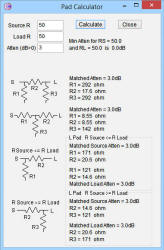|

Update:
Unfortunately, this website is no longer being published.
Über RF/microwave
engineer and Ham radio aficionado Cornell D. sent me an e-mail about a website
called Iowa Hills Software. Per the site's tag line, "The
analog and digital filter design
programs on this site are FREE. This web site, and the programs on it, are a
retired RF engineer's winter time hobby." If your primary interest is in calculating
theoretical values for filters and not being able to simulate "real world" effects
of component geometry and materials, packaging, and circuit boards, then it would
be hard to find a more comprehensive program for investigating the potential for
filter designs.
However, the software goes beyond presenting only the canonical form (basic)
of the circuits because, particularly for bandpass and bandstop filters, it is often
difficult or impossible to realize with actual components. To wit: "The canonical
form, or simplest form, is described in most textbooks, but is almost useless in
practice. These filters cannot be built unless the bandwidth is greater than about
50 percent. Even then, the component values required to build the filter become
impractical. The series inductors are prohibitively large in the sense that their
self resonant frequency becomes a major problem. It is also
 impractical, and usually impossible, to obtain
the nominal values needed, not to mention the problem with tolerances. In general,
the only place for a canonical band pass filter is in applications requiring very
wide filters. If you are new to RF filter design, take some free advice and don't
waste any time with these, except for the time required to understand their limitations.
Engineers understood this many years ago, and devised methods that add parts to
the design which in turn gives the engineer some latitude in the selection of component
values." Nearly
70 topologies are available to choose from based on type of filter
being designed. impractical, and usually impossible, to obtain
the nominal values needed, not to mention the problem with tolerances. In general,
the only place for a canonical band pass filter is in applications requiring very
wide filters. If you are new to RF filter design, take some free advice and don't
waste any time with these, except for the time required to understand their limitations.
Engineers understood this many years ago, and devised methods that add parts to
the design which in turn gives the engineer some latitude in the selection of component
values." Nearly
70 topologies are available to choose from based on type of filter
being designed.
Both FIR (finite impulse response) and IIR (infinite impulse response) are handled
for digital filters and opamp and RF are handled for analog filters. Lowpass, highpass,
bandpass, and bandstop (notch) responses, including all common transfer functions
like Butterworth, Chebyshev, Gaussian, and Papoulis (aka Optimum "L" filter) are
included. A choice of ideal components or standard component values is available,
as well as being able to perform a Monte Carlo analysis based on user-defined tolerances.
Gain (attenuation), group delay, phase, and return loss plots are available.
A Smith Chart program is also included for designing impedance matching circuits.
Buried within the Smith chart designer is a handy resistive attenuator designer.
In addition to the free software, there is also a huge amount of tutorial information
available from an obviously very experienced filter designer. An explanation of
the differences between IIR and FIR filters, a discussion group delay "without equations,"
a page on discrete inverse Laplace transforms, and much more is presented. Even
if you are familiar with filter design, you can probably find something new and
useful to you. There is a lot to explore.
Screen shots below show what I got with a few minutes of playing around with
the various features. The circuits shown are not meant to represent any particular
kind of filter, Smith Chart, or attenuator.
|

FIR Filter Designer

Opamp Filter Designer showing Monte Carlo Analysis

Resistive Attenuator Designer
|

RF analog Filter Designer showing Monte Carlo Analysis

Smith Chart
|
There is no contact information on the website except for a submission form and
an e-mail in the Help screen, so it seems the author prefers anonymity. I, however,
as the result of some Internet sleuthing, was able to locate a fairly certain identity,
but I will keep it confidential.
|



























 "
" impractical, and usually impossible, to obtain
the nominal values needed, not to mention the problem with tolerances. In general,
the only place for a canonical band pass filter is in applications requiring very
wide filters. If you are new to RF filter design, take some free advice and don't
waste any time with these, except for the time required to understand their limitations.
Engineers understood this many years ago, and devised methods that add parts to
the design which in turn gives the engineer some latitude in the selection of component
values." Nearly
impractical, and usually impossible, to obtain
the nominal values needed, not to mention the problem with tolerances. In general,
the only place for a canonical band pass filter is in applications requiring very
wide filters. If you are new to RF filter design, take some free advice and don't
waste any time with these, except for the time required to understand their limitations.
Engineers understood this many years ago, and devised methods that add parts to
the design which in turn gives the engineer some latitude in the selection of component
values." Nearly





